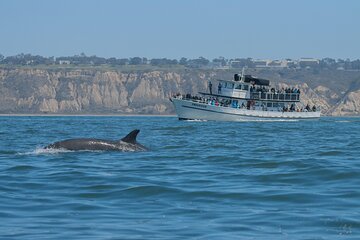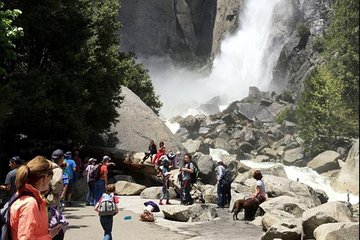Top Wanderwege in Yosemite

Yosemite National Park’s hiking trails are about as good as American scenery gets on two feet: paths leading from granite wonders to towering waterfalls, gigantic forests, and waving meadows straight out of a Bierstadt painting.
And while the best hikes in Yosemite are all of them, this handy guide will make sure you experience the park at the height of its splendor. It can get quite crowded in summertime (and hot by midday), so start any hiking early and consider going with a guide. From Yosemite backcountry trails to frontcountry, view-stacked easy hikes, Yosemite delivers. Here’s where to go.
1. Lower Yosemite Fall Trail

Yosemite Valley hikes don’t get more iconic—or easier—than the Lower Yosemite Fall Trail.
For first-time visitors, this one’s practically mandatory. The Lower Yosemite Fall Trail is a paved, 1-mile (1.6-kilometer) loop that winds around the base of the Yosemite Falls, one of the park’s signature icons. Believe it or not, this is only the lower half of the waterfall, yet it alone drops down 320 feet (98 meters). Visit in spring when this cascade is raging, and you’re bound to get a little wet along the way. By autumn, it often runs dry.
Insider tip: Come early—around sunrise early—if you want to avoid the crowds. This one’s mega-popular.
2. Yosemite Falls Trail

The Yosemite Falls Trail is a beast of a climb, but the views are worth it.
The Yosemite Falls Trail is a 3.6-mile (5.8-kilometer) jaunt to the top of North America’s tallest waterfall: a whopping 2,700 feet (823 meters). Of course, you don’t have to do it all. The first natural stopping point is 1,000 feet (304 meters) and countless switchbacks up to Columbia Rock, at the 1-mile (1.6 kilometer) mark.
It’s a spectacular view across the valley from here; if you can swing another half-mile (0.8 kilometer), you’ll get a particularly swell view of Upper Yosemite Fall. And if you manage the whole thing, you’ll wind up at Eagle Peak, the highest point on the valley's North Rim.
3. Guardians Loop Trail

The park’s biggest trees make for some big, big views along the Guardians Loop Trail.
Big trees tend to be synonymous with Sequoia and Kings Canyon as well as Redwood national parks, but Yosemite has its fair share of the towering giants, too. Catch the park’s biggest trees on the Guardians Loop Trail, in the park’s Mariposa Grove of Giant Sequoias section. The trail winds for 6.5 miles (10.5 kilometers) round-trip and also crosses the Grizzly Giant, the Telescope Tree, and the Mariposa Grove Cabin. Plus, the trail gets less crowded past the Grizzly Giant, offering the chance to commune with some of nature’s largest creations.
Insider tip: This area of the park is great for Jeep and 4WD tours, too.
4. Vernal Fall and Nevada Fall Trails

There’s no elevator in sight on the high-elevation Vernal Fall and Nevada Fall Trails.
Vernal Fall and Nevada Fall are two more must-see waterfalls. Hikers can climb to the top of both via the Mist Trail (5.4 miles, or 8.7 kilometers, round-trip), or turn the trek into a longer loop via the John Muir Trail. With a 2,000-foot (610-meter) elevation gain, it’s hardly one of the easy hikes in Yosemite, but it’s certainly one of the most scenic. The first mile or so is paved (though entirely uphill), and there’s a great view of Vernal Fall at the footbridge in this section. The crowds thin out from there—and the views only get better.
5. Cathedral Lakes Trail

See the quieter side of the park—and nature’s church—along the Cathedral Lakes Trail.
If you’re visiting Yosemite in summer, don’t overlook the Tuolumne Meadows area of the park; it’s only accessible in the warmer months, when Tioga Pass opens. The hike to do here is Cathedral Lakes: It’s a 7.6-mile (12-kilometer) round-trip trek from the Tuolumne Meadows Visitor Center with 1,000 feet (305 meters) of elevation gain to Upper Cathedral Lake.
To get there, you’ll be hiking along the famed John Muir Trail—making this a great beginner backpacking trip, too, for those with Yosemite hiking permits, aka wilderness permits.
6. Yosemite Valley Loop Trail

The Yosemite Valley Loop Trail is one loop to rule them all.
If you prefer less vertical hikes, check out the Yosemite Valley Loop Trail. It winds along one of the nation’s prettiest valley floors for 11.5 miles (18.5 kilometers), though you can do a half-loop, too. Since most visitors stay near Yosemite Falls, this trek comes with a surprising amount of solitude, with good views of El Capitan, the Merced River, Yosemite Falls, and more.
Insider tip: Bring a Yosemite hiking trails map for this one. Trailfinding is harder than you think here, and you’ll need to stay oriented.
7. Wapama Falls Trail

Did humans make this spot better or worse? Decide for yourself on the Wapama Falls Trail.
The Hetch Hetchy Reservoir didn’t always exist—in fact, before 1923, this part of the park was a dry, twin sibling to Yosemite Valley. But the need for a dam and drinking water prevailed, and now Hetch Hetchy is still like Yosemite Valley, but sunken.
See this less-traveled, historic side of the park on the Wapama Falls Trail, a 5-mile (8-kilometer) round-trip trek that follows the scenic shoreline of the reservoir. It also packs in excellent views of Wapama and Tueeulala Falls.
8. Wawona Meadow Loop

Take the pup for a wild time in the wildflowers on the Wawona Meadow Loop.
If you’ve got four legs or two wheels—a bike or a dog, that is—scope out the Wawona Meadow Loop, in the Wawona area of the park. It’s the only hiking trail in Yosemite that allows bikes or pups on leashes, and it loops around a gorgeous wildflower meadow come spring and summer. The trail is 3.5 miles (5.6 kilometers) and mostly flat, making it great for the entire crew: four legs, two wheels, or otherwise.
9. Half Dome

The Yosemite hiking trail reviews are in, and hiking to Half Dome is still the park’s most iconic trek.
If you can handle a 4,800-foot (1,463-meter) ascent (and descent) across 15 miles (24 kilometers) round-trip, then let Half Dome rise to the top of your list. Start around sunrise on a trek that culminates in precariously perched cables winding to the top. As this is a strenuous, advanced climb, do not attempt this one unless you’re vertigo-free, well hydrated, and adequately trained.
Did you know?: You need a permit to climb Half Dome, which are available via lottery—or you can try your luck at snagging one of the limited number of permits available 48 hours in advance.
Find things to do in California
Keep reading





























